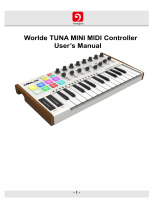
3
Operation .............................................................. 35
General Features ............................................. 35
Programs ....................................................... 35
About Programs ................................................. 35
Drum Programs ................................................. 36
Keygroup Programs ........................................... 37
Plugin Programs ................................................. 39
MIDI Programs ................................................... 40
Clip Programs .................................................... 41
CV Programs ..................................................... 42
Toolbar........................................................... 43
Menu ................................................................. 43
File .............................................................. 43
Edit ............................................................. 44
Tools .......................................................... 47
View............................................................ 48
Help ............................................................ 49
Mode Icons ........................................................ 50
Timing Controls .................................................. 50
Transport Controls ............................................. 51
Status ................................................................ 52
Inspector ........................................................ 53
Sequence .......................................................... 53
Track ................................................................. 53
Program ............................................................. 54
Channel Strips ................................................... 55
Pad & Keygroup Channel Strips .................. 55
Program Channel Strip ................................ 56
MIDI Track Channel Strip ............................ 57
Audio Track Channel Strip ........................... 58
Master & Submix Channel Strips ................. 59
Browser ......................................................... 60
File Browser ....................................................... 61
Expansion Browser ............................................ 62
Media Browser ................................................... 63
Project Info Browser ........................................... 64
Project Notes Browser ....................................... 65
Undo History Browser ........................................ 65
MIDI Learn Browser ........................................... 66
Editors ............................................................ 67
Grid Editor ......................................................... 68
MIDI ............................................................ 68
Audio .......................................................... 71
Wave Editor ....................................................... 75
List Editor ........................................................... 78
Track View ...................................................... 81
Mixer Window ................................................ 84
Panels ............................................................. 85
MIDI Keyboard ................................................... 85
Q-Links .............................................................. 86
Q-Link Setup ............................................... 87
Project ........................................................ 87
Program ..................................................... 88
Pad Scene .................................................. 88
Pad Parameters .......................................... 88
Screen ........................................................ 88
Pads .................................................................. 89
Program Editor ................................................... 89
Parameters ........................................................ 90
Project ............................................................... 90
Sampler & Looper .............................................. 91
Pad Banks & Mute ............................................. 91
Sequence List .................................................... 92
Performance Controls ........................................ 92
Song Parameters ............................................... 92
Preferences .................................................... 93
Audio ................................................................. 93
MIDI / Sync ........................................................ 93
Plugins ............................................................... 94
Sequencer ......................................................... 94
Hardware ........................................................... 95
Project Defaults .................................................. 95
Project Load/Save .............................................. 96
Record/Export ................................................... 96
General .............................................................. 96





















